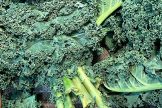
Versatile, good for you and fun to grow, cabbage is perhaps one of the more underrated stars of the vegie patch. Although they may not be everyone’s favourite, cabbages are high in vitamin C, and raw cabbage is a fantastic anti-oxidant.
Planting Time: Sept – May
Position: Full sun, no wind
Water Needs: Moderate
Difficulty: Moderate
How Long: 14 – 17 weeks

When planting cabbages, the secret is sun, sun, sun! Provide them with a bit of protection from wind, either using a shade cloth windbreak, or some taller plants nearby. To minimise the risk of pests and diseases taking hold, ensure they are not planted into a bed that has had broccoli, cauliflower or brussel sprouts within the last three years.
Depending on the variety of cabbage you plant, leave at least 40cm between each seedling, but, to allow for them to grow to their full potential, the more space you can allocate the better.
Of all the members of the Brassiaceae family (including cauliflowers, broccoli and brussel sprouts), cabbages are the hungriest and require an incredibly rich soil. The soil should be deep, well-drained and have a load of compost (including well-rotted manure) through it, with an ideal pH of 6.5-7. Hilling compost around the base of plants is a good idea throughout the growing period, to both feed and prevent cabbages toppling.
For tastier, healthier cabbages, look no further than liquid worm castings, the perfect liquid feed. Apply a weak mixture fortnightly for improved vigour. In areas with high humidity or rainfall, a seaweed based liquid feed once a month will help prevent pest and disease issues.
Water stress can be a problem for cabbages, so water deeply and consistently. It is important to ensure water reaches the roots, so, if the area is mulched, consider subsurface irrigation or pull mulch away when watering. Avoid wetting foliage, as this is an open invitation for mildews to move in. Cabbages will suffer badly in waterlogged soil, ensure good drainage, and check soil moisture BEFORE watering.
There are loads of different varieties of cabbage, and many of them are quick and easy to grow. When you’re in the nursery, keep an eye out for some of these lovely leafy varieties:
Green Coronet: A fairly large sized cabbage, to about 3kg at maturity. This one is fairly easy to grow, and is a little more cold tolerant than some other varieties.
Savoy King: An oldie but a goodie, Savoy King produces large, flattish heads on big cabbages. Excellent flavour, but don’t plant these guys to close together…they need room to grow.
Sugarloaf: A cone shaped sweet and tasty cabbage that matures fairly early in the season. Dead easy to grow.
Red: Good looking cabbages, the Red varieties form tight heads to about 1kg. Nice flavour and a colourful addition to salads and coleslaws.
Cannonball: A smaller growing variety, Cannonball is suitable for smaller patches and large tubs. At maturity, heads are small and firm, and give a bit of oomph to your stir fry.
Chinese cabbage varieties: Cylindrical to barrel shaped, the Chinese cabbage varieties (including our old favourite the Wong Bok) are generally sweeter and milder in flavour than traditional cabbages.

Cabbage White Butterfly
The Cabbage White Butterfly (Pieris rapae) and the Cabbage Moth (Plutella xylostella), along with their offspring (the very hungry catterpillars!) are responsible for the eaten leaves and irregular holes in the leaves of vegetables such as Cabbage, Cauliflower, Kale, Broccoli, Brussels Sprouts, Bok Choi, Wombok and Watercress. There are a number of ways to keep your vegies safe from them, checkout our Cabbage White Butterfly and Cabbage Moth factsheet.
Companions
Plant with dill, sage, mint, nasturtium, rosemary, beetroot, beans, lettuce and cucumber.
Avoid planting cabbages with garlic, tomatoes, strawberries and rue. Depending on variety, cabbages can be harvested between 14-17 weeks. Remove outer leaves and eat firm, sweet, young heads.





